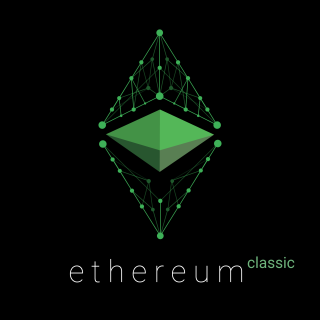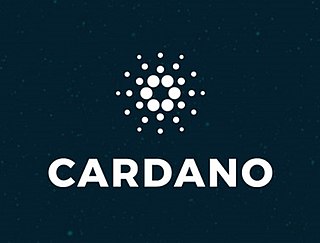Proof-of-stake (PoS) protocols are a class of consensus mechanisms for blockchains that work by selecting validators in proportion to their quantity of holdings in the associated cryptocurrency. This is done to avoid the computational cost of proof-of-work (POW) schemes. The first functioning use of PoS for cryptocurrency was Peercoin in 2012, although the scheme, on the surface, still resembled a POW.

Ethereum is a decentralized blockchain with smart contract functionality. Ether is the native cryptocurrency of the platform. Among cryptocurrencies, ether is second only to bitcoin in market capitalization. It is open-source software.
A decentralized autonomous organization (DAO), sometimes called a decentralized autonomous corporation (DAC), is an organization managed in whole or in part by decentralized computer program, with voting and finances handled through a blockchain. In general terms, DAOs are member-owned communities without centralized leadership. The precise legal status of this type of business organization is unclear.
A blockchain is a distributed ledger with growing lists of records (blocks) that are securely linked together via cryptographic hashes. Each block contains a cryptographic hash of the previous block, a timestamp, and transaction data. Since each block contains information about the previous block, they effectively form a chain, with each additional block linking to the ones before it. Consequently, blockchain transactions are irreversible in that, once they are recorded, the data in any given block cannot be altered retroactively without altering all subsequent blocks.
A decentralised application is an application that can operate autonomously, typically through the use of smart contracts, that run on a decentralized computing, blockchain or other distributed ledger system. Like traditional applications, DApps provide some function or utility to its users. However, unlike traditional applications, DApps operate without human intervention and are not owned by any one entity, rather DApps distribute tokens that represent ownership. These tokens are distributed according to a programmed algorithm to the users of the system, diluting ownership and control of the DApp. Without any one entity controlling the system, the application is therefore decentralised.

ShapeShift, founded in 2014 by Erik Voorhees was a cryptocurrency exchange headquartered in Switzerland that turned into a permissionless DAO operating on the blockchain. Its decentralized application empowers users to trade the Bitcoin, Ethereum, and 10,000+ crypto assets across 14 chains.

Ethereum Classic is a blockchain-based distributed computing platform that offers smart contract (scripting) functionality. It is open source and supports a modified version of Nakamoto consensus via transaction-based state transitions executed on a public Ethereum Virtual Machine (EVM).

Cardano is a public blockchain platform. It is open-source and decentralized, with consensus achieved using proof of stake. It can facilitate peer-to-peer transactions with its internal cryptocurrency, ADA.

Polkadot is a blockchain platform and cryptocurrency. The native cryptocurrency for the Polkadot blockchain is the DOT. It is designed to allow blockchains to exchange messages and perform transactions with each other without a trusted third-party. This allows for cross-chain transfers of data or assets, between different blockchains, and for decentralized applications (DApps) to be built using the Polkadot Network.

IOTA is an open-source distributed ledger and cryptocurrency designed for the Internet of things (IoT). It uses a directed acyclic graph to store transactions on its ledger, motivated by a potentially higher scalability over blockchain based distributed ledgers. IOTA does not use miners to validate transactions, instead, nodes that issue a new transaction on the network must approve two previous transactions. Transactions can therefore be issued without fees, facilitating microtransactions. The network currently achieves consensus through a coordinator node, operated by the IOTA Foundation. As the coordinator is a single point of failure, the network is currently centralized.

The Open Network is a decentralized computer network consisting of a layer-1 blockchain with various components. TON was originally developed by Nikolai Durov and the messaging platform, Telegram and now embraced by a global community of independent contributors.

TRON is a decentralized, blockchain-based operating system with smart contract functionality, proof-of-stake principles as its consensus algorithm and a cryptocurrency native to the system, known as Tronix (TRX). It was established in March 2014 by Justin Sun and since 2017 has been overseen and supervised by the TRON Foundation, a non-profit organization in Singapore, established in the same year. It is open-source software.

Avalanche is a decentralized, open-source proof of stake blockchain with smart contract functionality. AVAX is the native cryptocurrency of the platform.

Ouroboros is a family of proof-of-stake consensus protocols used in the Cardano and Polkadot blockchains. It can run both permissionless and permissioned blockchains.
Decentralized finance offers financial instruments without relying on intermediaries such as brokerages, exchanges, or banks by using smart contracts on a blockchain, mainly Ethereum. DeFi platforms allow people to lend or borrow funds from others, speculate on price movements on assets using derivatives, trade cryptocurrencies, insure against risks, and earn interest in savings-like accounts. DeFi uses a layered architecture and highly composable building blocks. Some applications promote high-interest rates but are subject to high risk. Coding errors and hacks have been common in DeFi.

Dai is a stablecoin token on the Ethereum blockchain whose value is kept as close to one United States dollar as possible by decentralized parties incentivized by smart contracts to perform actions that affect the token's supply and therefore its price. Dai is maintained and regulated by MakerDAO, a decentralized autonomous organization composed of the owners of its governance token, MKR, who may propose and vote on changes to certain parameters in its smart contracts.

0x is an open-source, decentralized exchange infrastructure that enables the exchange of tokenized assets on multiple blockchains. Developers can use 0x to incorporate exchange functionality into their applications, and market makers can use 0x to create markets for cryptocurrencies and tokens. ZRX, an Ethereum ERC-20 token, is the native governance and staking token of 0x. Individuals who own ZRX can vote on protocol changes and stake their tokens to earn liquidity rewards in Ether (ETH). The project's creator and core developer is 0x Labs.
Stacks, formerly Blockstack, is a blockchain platform for smart contracts, decentralized finance ("DeFi"), non-fungible tokens (NFTs), and decentralized apps ("DApps"). Stacks blockchain is a layer for bitcoin similar to the Lightning Network.
ICON is a decentralized, open-source blockchain with smart contract functionality. ICX is the native cryptocurrency of the platform.
Nervos Network is a proof-of-work blockchain platform which consists of multiple blockchain layers that are designed for different functions. The native cryptocurrency of this layer is called CKB. Smart contracts and decentralized applications can be deployed on the Nervos blockchain. The Nervos Network was founded in 2018.












